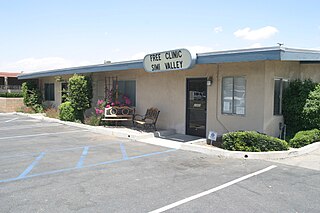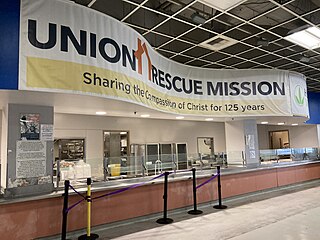Related Research Articles

A skid row, also called skid road, is an impoverished area, typically urban, in English-speaking North America whose inhabitants are mostly poor people "on the skids". This specifically refers to people who are poor or homeless, considered disreputable, downtrodden or forgotten by society. A skid row may be anything from an impoverished urban district to a red-light district to a gathering area for people experiencing homelessness or drug addiction. In general, skid row areas are inhabited or frequented by impoverished individuals and also people who are addicted to drugs. Urban areas considered skid rows are marked by high vagrancy, dilapidated buildings, and drug dens, as well as other features of urban blight. Used figuratively, the phrase may indicate the state of a poor person's life.

A free clinic or walk in clinic is a health care facility in the United States offering services to economically disadvantaged individuals for free or at a nominal cost. The need for such a clinic arises in societies where there is no universal healthcare, and therefore a social safety net has arisen in its place. Core staff members may hold full-time paid positions, however, most of the staff a patient will encounter are volunteers drawn from the local medical community.
In November 2004, voters in the U.S. state of California passed Proposition 63, the Mental Health Services Act (MHSA), which has been designed to expand and transform California's county mental health service systems. The MHSA is funded by imposing an additional one percent tax on individual, but not corporate, taxable income in excess of one million dollars. In becoming law in January 2005, the MHSA represents the latest in a Californian legislative movement, begun in the 1990s, to provide better coordinated and more comprehensive care to those with serious mental illness, particularly in underserved populations. Its claim of successes thus far, such as with the development of innovative and integrated Full Service Partnerships (FSPs), are not without detractors who highlight many problems but especially a lack of oversight, large amount of unspent funds, poor transparency, lack of engagement in some communities, and a lack of adherence to required reporting as challenges MHSA implementation must overcome to fulfill the law's widely touted potential.

AIDS Healthcare Foundation (AHF) is a Los Angeles-based 501(c)(3) nonprofit organization that provides HIV/AIDS prevention, treatment, and advocacy services. As of 2024, AHF operates about 400 clinics, 69 outpatient healthcare centers, 62 pharmacies, and 22 Out of the Closet thrift stores across 15 U.S. states, Washington, D.C., Puerto Rico, and 46 countries, with over 5,000 employees, and provides care to more than two million patients. The organization's aim is to end the AIDS epidemic by ensuring access to quality healthcare, including HIV and STD testing, prescription of medications like Pre-exposure Prophylaxis (PrEP), and referrals to specialty pharmacies. AHF is the largest provider of PrEP in the United States, though its founder Michael Weinstein has received criticism for his past opposition to the drug.

Health Services Los Angeles County, officially the Los Angeles County Department of Health Services, operates the public hospitals and clinics in Los Angeles County and is the United States' second largest municipal health system, after NYC Health + Hospitals.

Skid Row is a neighborhood in Downtown Los Angeles. The area is officially known as Central City East.

Patient dumping or homeless dumping is the practice of hospitals and emergency services inappropriately releasing homeless or indigent patients to public hospitals or on the streets instead of placing them with a homeless shelter or retaining them, especially when they may require expensive medical care with minimal government reimbursement from Medicaid or Medicare. The term homeless dumping has been used since the late 19th century and resurfaced throughout the 20th century alongside legislation and policy changes aimed at addressing the issue. Studies of the issue have indicated mixed results from the United States' policy interventions and have proposed varying ideas to remedy the problem.
University Muslim Medical Association, Inc. (UMMA) Community Clinic is the first Muslim American founded community-based health organization in the United States. Located in South Los Angeles, UMMA has a culturally and religiously diverse staff serving an equally diverse community.

Venice Family Clinic is a community health center based in Los Angeles, California.

The Los Angeles County Department of Public Health (DPH) provides public health services to Los Angeles County residents. Barbara Ferrer is the Director for the Los Angeles County Department of Public Health. Muntu Davis is the Los Angeles County Public Health Officer. Jeffrey Gunzenhauser is the Interim Health Officer and Medical Director for Los Angeles County.
LAMP Community is a Los Angeles–based nonprofit organization located in Skid Row that seeks to permanently end homelessness, improve health, and build self-sufficiency among men and women living with severe mental illness.

The Local Initiative Health Authority for Los Angeles County is a public agency that provides health insurance for low-income individuals in Los Angeles County through four health coverage programs including Medi-Cal.
The community health center (CHC) in the United States is the dominant model for providing integrated primary care and public health services for the low-income and uninsured, and represents one use of federal grant funding as part of the country's health care safety net. The health care safety net can be defined as a group of health centers, hospitals, and providers willing to provide services to the nation's uninsured and underserved population, thus ensuring that comprehensive care is available to all, regardless of income or insurance status. According to the U.S. Census Bureau, 29 million people in the country were uninsured in 2015. Many more Americans lack adequate coverage or access to health care. These groups are sometimes called "underinsured". CHCs represent one method of accessing or receiving health and medical care for both underinsured and uninsured communities.
Healthy Way LA (HWLA) was a free public health care program available to underinsured or uninsured, low-income residents of Los Angeles County from 2007 until 2014. The program, administered by the Los Angeles County Department of Health Services (LADHS), was a Low Income Health Program (LIHP) approved under the Section 1115 Medicaid Waiver. HWLA was succeeded by My Health LA, a no-cost health care program which ran from 2014 until 2024, when access to Medi-Cal was expanded.
The Banyan is a non-governmental organization based in Chennai, India that was founded in 1993 by Vandana Gopikumar and Vaishnavi Jayakumar to cater to mentally-ill and homeless women in the city.

The Star Apartments are a purpose-built residential housing complex on Los Angeles' Skid Row that caters to the needs of the long-term homeless. Opened in October 2014, the Star Apartments include 102 units averaging 350 square feet, alongside amenities such as on-site medical services, counseling, fitness and art facilities and a community garden. The complex was developed by the Skid Row Housing Trust, and designed by Los Angeles–based firm Michael Maltzan Architecture. It received LEED Platinum status in August 2015. The building also houses the Los Angeles County Department for Health Services' Housing for Health division.
Mollie Ellen Lowery was an American advocate for homeless and mentally ill people in Los Angeles. In 1984, she co-founded the non-profit housing support center, LAMP, and in 2006 she founded an advocacy group, Housing Works.
Ben Weingart (1888–1980) was an American real estate investor and developer, influential in the development of various areas of southern California, including Lakewood, California. A self-made man, Weingart became one of the richest men in California, building a fortune of nearly $100 million, and the Weingart Foundation, his philanthropic organization, has provided grants and support to many charitable causes, having granted more than $950 million in support of various Southern California social services, educational and community programs.
The Safer Cities Initiative is an initiative to reduce crime in Skid Row, Los Angeles. While the initiative prominently resulted in heightened police enforcement in Skid Row, it had other facets including prosecuting hospitals who dumped poor patients at Skid Row, as well as services like tree trimming.

The Union Rescue Mission, commonly abbreviated as the URM, is a Christian homeless shelter in the Skid Row neighborhood of Los Angeles, California. It is the oldest in the city and the largest private homeless shelter in the United States. The organization behind the URM is a 501(c)(3) nonprofit that was established in 1891.
References
- ↑ "Weingart Center official website" . Retrieved 2010-10-07.
- ↑ "El Rey Hotel 1923 by architect Charles F. Whittlesey". Downtown Los Angeles Historic Buildings. Retrieved 2010-10-07.
- ↑ Scott, Gregory (2010-10-06). "'Band of Billionaires' Should Consider Skid Row". The Huffington Post. Retrieved 2010-10-07.
- ↑ Machado, Helen (2010-07-08). "Dedication of the Weingart Center Garden Project". Congresswoman Lucille Roybal-Allard. Retrieved 2010-10-07.
- ↑ "Skid Row Homeless Health Care Initiative". Community Clinic Association of Los Angeles County. Retrieved 2010-10-07.
- ↑ Wood, David (1991-10-01). "Barriers to Medical Care for Homeless Families Compared With Housed Poor Families". Archives of Pediatrics & Adolescent Medicine. 145 (10): 1109. doi:10.1001/archpedi.1991.02160100041021. ISSN 1072-4710.
- ↑ Gordon, Adam J.; Montlack, Melissa L.; Freyder, Paul; Johnson, Diane; Bui, Thuy; Williams, Jennifer (March 2007). "The Allegheny Initiative for Mental Health Integration for the Homeless: Integrating Heterogeneous Health Services for Homeless Persons". American Journal of Public Health. 97 (3): 401–405. doi:10.2105/ajph.2006.094284. ISSN 0090-0036. PMC 1805021 . PMID 17267708.
- ↑ "Building for Homeless Health - LA Clinics Paving the Way for Innovative Solutions - Community Clinic Association of Los Angeles County". Community Clinic Association of Los Angeles County. 2018-07-16. Retrieved 2018-09-08.